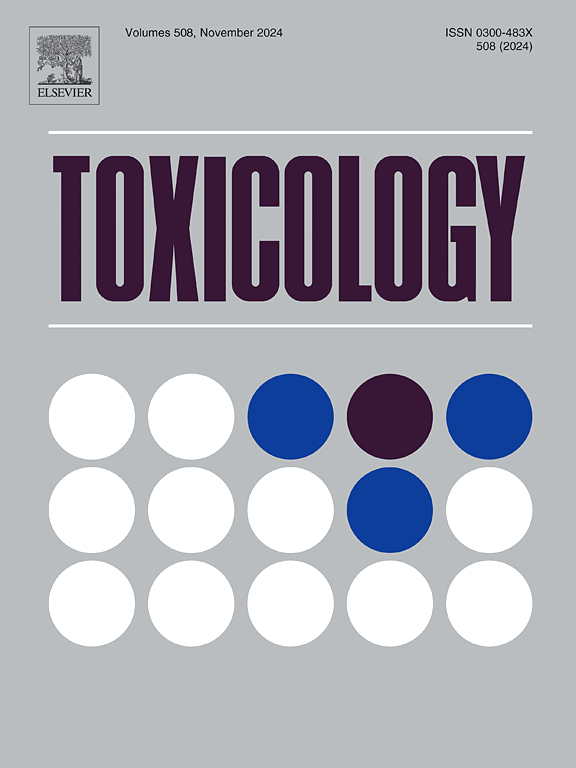Changes of N6-methyladenosine and ferroptosis in cadmium-induced reproductive toxicity of male mice fed a high fat and high sugar diet
IF 4.6
3区 医学
Q1 PHARMACOLOGY & PHARMACY
引用次数: 0
Abstract
Cadmium (Cd) and high-fat and high-sugar diet (HFHS) are risk factors contributing to the decline in male sperm quality. N6-methyladenosine (m6A) is essential in the processes of testicular development and spermatogenesis. Ferroptosis, a form of cell death that depends on iron, is prone to causing testicular dysfunction. However, the changes in m6A modification regulatory proteins and ferroptosis signaling molecules in male mice with sperm abnormalities resulting from combined exposure to Cd and HFHS remain incompletely elucidate. Our present data indicate that the combined treatment of Cd and HFHS significantly reduced sperm quality in comparison to those in single Cd or HFHS treatment. In addition, indicators related to ferroptosis in the combined treatment of Cd and HFHS group have also undergone significant changes. In detail, the contents of malondialdehyde (MDA) and Fe2+ as well as Slc7a11 expression were increased while Gclc expressions were reduced in the testicular tissue of Cd and HFHS combined treatment mice. Further detect results showed that the combined exposure to Cd and HFHS synergistically elevated the m6A modification levels alongside a downregulation of the Mettl3, Fto, Alkbh5 and Ythdc2 at the protein level when compared with those in single Cd or HFHS treatment. Altogether, it can be inferred that Cd and HFHS combined treatment may alter the levels of m6A modification regulatory proteins in testicular tissue, leading to increased Fe2+ and MDA production, thus activating the Slc7a11/Gpx4 signaling pathway, ultimately decreasing the sperm quality in mice, providing preliminary evidence for the occurrence of ferroptosis in testicular cells. Our findings may provide direction for the study of reproductive toxicity of cadmium and offer reference for the selection of molecular targets.
n6 -甲基腺苷和铁下垂在高脂高糖饲料镉致雄性小鼠生殖毒性中的变化
镉(Cd)和高脂高糖饮食(HFHS)是导致男性精子质量下降的危险因素。n6 -甲基腺苷(m6A)在睾丸发育和精子发生过程中起重要作用。铁下垂是一种依赖铁的细胞死亡形式,容易导致睾丸功能障碍。然而,在Cd和HFHS联合暴露导致精子异常的雄性小鼠中,m6A修饰调节蛋白和铁凋亡信号分子的变化尚不完全清楚。我们目前的数据表明,与单一Cd或HFHS治疗相比,Cd和HFHS联合治疗显著降低了精子质量。此外,Cd与HFHS联合治疗组的铁下垂相关指标也发生了显著变化。Cd和HFHS联合治疗小鼠睾丸组织中丙二醛(MDA)和Fe2+含量升高,Slc7a11表达降低,Gclc表达降低。进一步的检测结果表明,与单一Cd或HFHS处理相比,Cd和HFHS联合暴露可协同提高m6A修饰水平,同时在蛋白水平上下调Mettl3、Fto、Alkbh5和Ythdc2。综上所述,可以推断Cd和HFHS联合治疗可能改变睾丸组织中m6A修饰调节蛋白的水平,导致Fe2+和MDA的产生增加,从而激活Slc7a11/Gpx4信号通路,最终降低小鼠精子质量,为睾丸细胞发生铁凋亡提供了初步证据。本研究结果可为镉的生殖毒性研究提供指导,并为分子靶点的选择提供参考。
本文章由计算机程序翻译,如有差异,请以英文原文为准。
求助全文
约1分钟内获得全文
求助全文
来源期刊

Toxicology
医学-毒理学
CiteScore
7.80
自引率
4.40%
发文量
222
审稿时长
23 days
期刊介绍:
Toxicology is an international, peer-reviewed journal that publishes only the highest quality original scientific research and critical reviews describing hypothesis-based investigations into mechanisms of toxicity associated with exposures to xenobiotic chemicals, particularly as it relates to human health. In this respect "mechanisms" is defined on both the macro (e.g. physiological, biological, kinetic, species, sex, etc.) and molecular (genomic, transcriptomic, metabolic, etc.) scale. Emphasis is placed on findings that identify novel hazards and that can be extrapolated to exposures and mechanisms that are relevant to estimating human risk. Toxicology also publishes brief communications, personal commentaries and opinion articles, as well as concise expert reviews on contemporary topics. All research and review articles published in Toxicology are subject to rigorous peer review. Authors are asked to contact the Editor-in-Chief prior to submitting review articles or commentaries for consideration for publication in Toxicology.
 求助内容:
求助内容: 应助结果提醒方式:
应助结果提醒方式:


